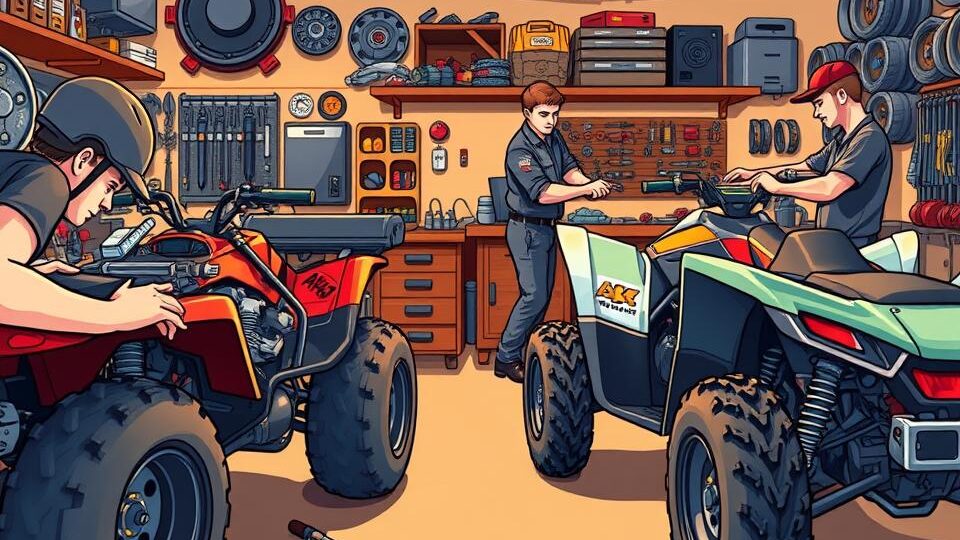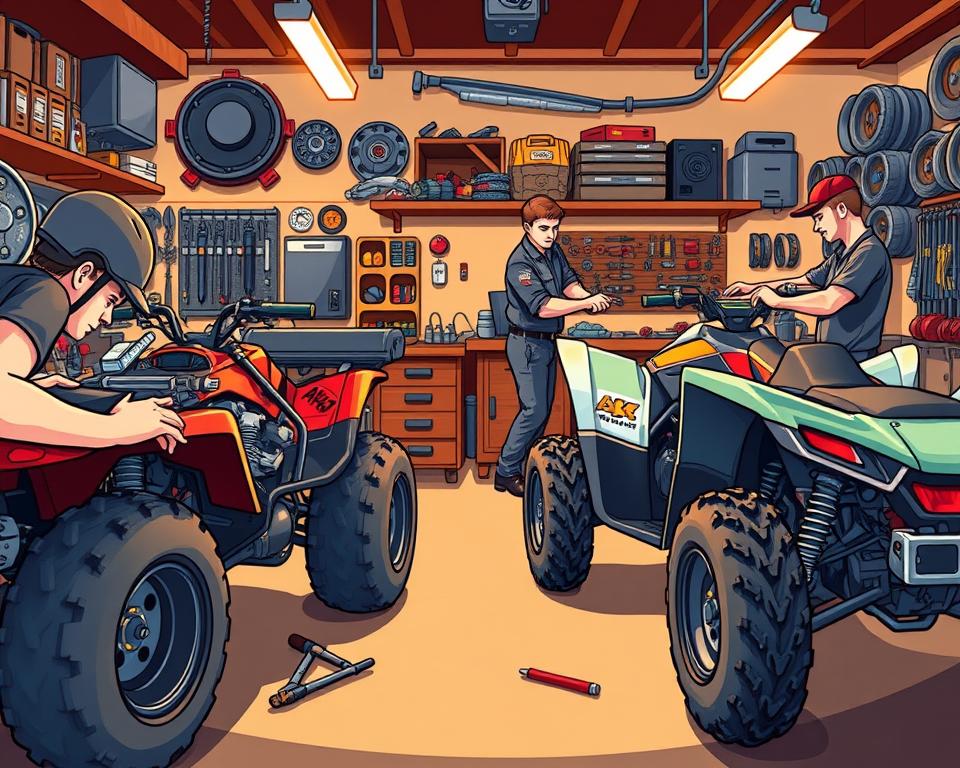
Renegade Lift Kit Shock Absorber Selection Guide
Must-Have ATV Off-Road Safety Checklist
It might surprise you to discover nearly around 450,000 ATV-related injuries are treated in U.S. emergency rooms each year? Such a high number stresses the importance of being prepared and safe on the trails. Use this Essential ATV Off-Road Checklist to ensure every ride is safe and fun. Whether you’re tackling rocks or dunes, it’s all included. With the right safety gear and Can Am outlander lift kit essentials, you can minimize risks and boost your adventure.
Central Ideas
- Use this checklist first to prep safely and thoroughly.
- Don’t hit the trail without this ATV safety gear list.
- Maintenance matters: check often, ride better.
- Water and snacks—musts for long off-road sessions.
- Master your GPS and maps to stay on track.
- Weather can flip fast—be ready with proper gear.
- Always carry essential tools and recovery kits for on-trail repairs and emergencies.
Understanding the Importance of Safety Gear
When you ride off-road, safety must come first. The excitement of ATVs brings potential hazards. Safety gear is essential for protecting riders from accidents and injuries. A full gear check means a safer outing.

Essential Protective Gear
Maximizing protection involves several key items:
- Helmets: Always use a DOT helmet to guard against head trauma.
- Eye Protection: Use goggles to shield your eyes from dust and debris.
- Riding Gloves: Gloves help you hold on and protect your skin.
- Boots: Wear sturdy boots that cover the ankles to prevent injuries.
- Protective Armor: Wear armor to guard your torso on rough trails.
- Neck Braces: A neck brace protects your spine in a crash.
Emergency Preparedness
Emergency preparedness is just as important as protective gear. A well-packed kit might save your life. Key items to include are:
- First aid kit
- Multi-tool
- Tire repair kits
- Portable air compressors
- Emergency blankets
- Whistles
- Matches
ATV Equipment for Optimal Performance
Gear choices affect how well your ATV runs. Pack these essentials for any trail. Regularly following an ATV maintenance checklist helps maintain your machine’s functionality and longevity.
Must-Have ATV Equipment
- Durable Tires: Terrain-specific tires keep you glued to the track.
- Cargo Systems: Keep tools and spares within reach.
- Quality Fuel Tank: Opt for a robust tank to avoid drips and dry runs.
- First Aid Kit: Be ready for scrapes and bruises with a first aid pack.
Regular Maintenance for Longevity
Routine care keeps breakdowns at bay. Regular inspections should encompass:
- Checking air filters to keep the engine running smoothly.
- Grease your chain often to avoid skip and wear.
- Inspecting brakes for safety before each ride.
Follow these steps to prep your ride for every trail.
The Essential ATV Off-Road Checklist
Don’t skip your pre-ride safety scan. A quick check prevents major headaches. Each pre-ride inspection step requires attention to detail. Spend a few minutes now for peace of mind later.
Pre-Ride Inspection Basics
Never ride without a quick systems check. This quick evaluation helps riders identify and address issues before they start. Key elements to check include:
- Tire pressure and tread condition
- Fluid levels such as oil and fuel
- Brakes and controls functionality
- Operational lights and horn
- Chain or driveshaft integrity
T-CLOC Inspection Method
T-CLOC covers every critical system. It covers Tires and Wheels, Controls, Lights, Oil and Fuel, and Chain/Driveshaft. This method ensures all critical areas are covered:
| Inspection Area | Checklist Items |
|---|---|
| Tires and Wheels | Check tire pressure, inspect tread depth, look for damage |
| Controls | Test brakes, throttle, and clutch for smooth operation |
| Lights | Ensure headlights, brake lights, and indicators are functioning |
| Oil and Fuel | Check oil level, inspect for leaks, and fill fuel tank |
| Chain/Driveshaft | Examine for wear, proper tension, and lubrication |
Check everything—ride with confidence. Keep the adventure going with no surprises.
Hydration and Nutrition for Long Rides
Long ATV rides require careful attention to hydration and nutrition. Riders often underestimate their fluid needs, making it essential to plan ahead. Carry extra water to prevent fatigue and keep energy levels up during the adventure. Nutritious snacks power you through rough stretches.
Importance of Staying Hydrated
Dehydration leads to poor decisions and slow reflexes. It’s important to drink water consistently, not just when thirsty. Hydration bladders track consumption at a glance.
High-Energy Snacks to Pack
Good snacks keep you sharp and energized. Opt for non-perishable items that are easy to consume. Some ideal choices include:
- Protein bars
- Nut mixes
- Dried fruits
- Beef jerky
Grab-and-go snacks let you refuel on the move. Ensure to pack a variety to keep your energy levels high and your taste buds satisfied.
Navigation Tools for Off-Roading Adventures
Exploring uncharted territory demands reliable navigation tools. A dependable nav setup means you’ll always find your way.
Advanced GPS Systems
High-end GPS units guide you through the wild. GPS should work without cell service and last all day. Brands like Garmin and TomTom offer models designed for off-road use, ensuring durability and precision.
Traditional Navigation Aids
Don’t ditch old-school compasses and maps. Waterproof maps and compasses are vital backups when your GPS fails. Map-and-compass know-how keeps you in control. Tech plus tools equals total navigation readiness.
Communication Equipment for Safety
When phones fail, two-way radios deliver. Using reliable ATV communication gear is vital for safety. Talking to your team prevents misadventures.
For seamless communication among group members, a quality two-way radio is highly recommended. These devices ensure clear audio over long distances. They allow for real-time updates on any changes or hazards. When choosing two-way radios, look for models with:
- Weatherproof construction to resist the elements
- Long battery life for extended trips without needing a recharge
- Multiple channels for clear communication without interference
No ride is complete without radios. They keep everyone coordinated and secure. Radios cut through noise and barriers. With the right tools, your off-road trips will be smoother and more enjoyable.
Self-Rescue Gear for ATV Riders
Every ATV rider should be ready for unexpected situations on the trail. With the right kit, you’ll tackle obstacles solo. Prepared riders make safer group members.
Winches and Recovery Kits
A winch can drag you out of any rut. A winch paired with a detailed ATV recovery kit is even more effective. Recovery kits usually include:
- Tow straps
- D-rings
- Recovery boards
- Gloves
Knowledge plus gear equals true self-rescue. With quality ATV recovery kits, you can overcome mud, rocks, or other obstacles and continue your journey.
Trail Recovery Essentials
Winches are just the start; several trail recovery essentials are also critical for off-road adventures. These include:
| Equipment | Purpose |
|---|---|
| Recovery Straps | Used for towing or pulling ATVs out of tight situations. |
| Shovel | Helps clear obstacles and dig out vehicles when stuck. |
| Traction Mats | Provides grip under tires in muddy or slick conditions. |
| Portable Air Compressor | Enables quick tire inflation after deflating for better traction. |
Arming your ATV with the right self-rescue gear ensures you can handle any obstacles. Knowing how to use these tools greatly improves safety and adventure on your off-road excursions.
Staying Adaptable: Preparing for Weather Changes
Weather variability is a major challenge in off-roading. Be prepared for sun, rain, or wind at any moment. Pack for every possible forecast.
Layering your clothes is key to adapting to temperature changes. A dry base keeps you cozy. Fleece or wool gives you warmth on demand. Lastly, have a waterproof and wind-resistant outer shell. Adapt to cold, heat, or storms easily.
Weather-Appropriate Clothing
- Rain Shells: Stay dry when the sky opens up.
- Ventilated Off-Road Pants: Stay cool and dry with breathable pants.
- Sun Protection: Lightweight, long-sleeved shirts and wide-brimmed hats safeguard against harmful UV rays.
- Insulated Gloves: Keeps hands warm and functional during colder rides.
Gear up for every climate challenge. Stay focused on the trail, not on being wet or cold.
Tools for On-Trail Repairs
Your toolkit can make or break your day on the trail. Don’t skimp on repair gear. Tackle trailside trouble with confidence.
Must-Have Tools and Kits
Keep these tools handy at all times. Pack only the essentials—no junk. Critical ATV repair tools might include:
- Tire irons for changing flat tires
- Pliers for gripping and cutting
- Wrenches for various sizes of bolts and nuts
- A multi-tool for versatility
- Spare items such as spark plugs and electrical wire
- Duct tape for quick fixes
Be your own mechanic on the trail.
Basic Emergency Supplies
Tools alone won’t save you—bring these extras. These supplies help ensure your safety in challenging situations:
- First aid kit for injuries
- Flashlight with extra batteries for night-time visibility
- Emergency whistle for signaling assistance
- Reflective triangles or flares to warn other riders
- Water and high-energy snacks for sustenance
Preparedness significantly impacts your off-roading experience. Never leave home without them.
To Conclude
Success and enjoyment in off-road adventures depend on thorough preparation. Using the Essential ATV off-road checklist and acquiring gear from trusted sources is key. This ensures you’re ready for any terrain.
Load up on safety, navigation, and comms gear. Prep wisely for peak thrills and protection. Embrace excitement, ditch the doubts.
Gear up, stay sharp, and savor every off-road second. The journey is as important as the destination. By following the Essential ATV off-road checklist, you’re set for an incredible adventure in the great outdoors.
FAQ
What should I include in my ATV safety gear checklist?
Your ATV safety gear checklist should include a DOT-approved helmet and goggles. Don’t skip gloves, boots, and armor. Neck braces help guard your spine. Remember to pack an emergency kit with a first aid kit and multi-tools for preparedness.
Tips for ATV upkeep?
Keep filters clean and chain well-lubed. Inspect brakes as well. A consistent maintenance routine extends your machine’s life and keeps it ready for off-road adventures.
What does the T-CLOC inspection method entail?
The T-CLOC inspection method covers several key areas. It includes checking Tires and Wheels, Controls, Lights, Oil and Fuel, and Chain/Driveshaft. Using T-CLOC guarantees safe, smooth rides.
How to gauge water needs off-road?
Overestimate your water needs. Accurately estimating hydration needs prevents fatigue, which is critical during long rides. Hydro packs let you drink without stopping.
How to stay on course off-road?
Use an off-road GPS unit. Backup with maps and a compass ensures you never get lost.
Why carry two-way radios?
Comms keep groups connected and safe. Radios work where phones don’t.
What self-rescue gear should every ATV rider carry?
Be ready with winch and recovery essentials. This kit should include tow straps, D-rings, and recovery boards.
How to handle trail weather swings?
Use a base, mid, and shell layering system. Waterproof gear is necessary to stay dry during unexpected rain. Wear sun-blocking fabrics and hats.
What tools should I pack for on-trail repairs?
For on-trail repairs, pack a basic tool kit for minor fixes. Have spares and tape for quick fixes.